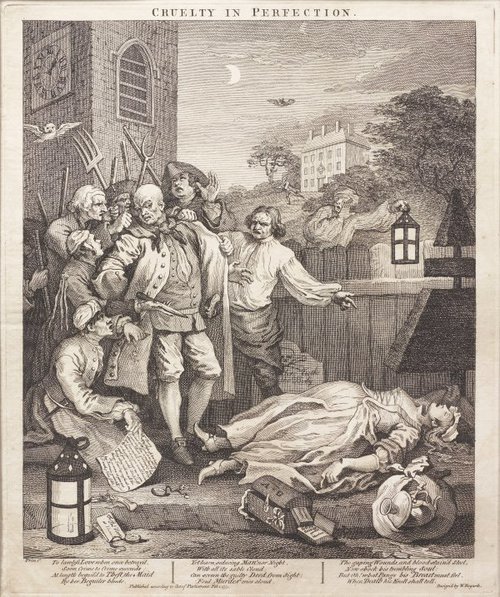Title
A Harlot's Progress: plate 3
1732
Artist
-
Details
- Date
- 1732
- Media category
- Materials used
- etching and engraving
- Dimensions
- 32.0 x 39.0 cm platemark; 47.0 x 59.2 cm sheet
- Credit
- Purchased 2006
- Location
- Not on display
- Accession number
- 324.2006.3
- Copyright
- Artist information
-
William Hogarth
Works in the collection
- Share
-
-
About
Hogarth trained as a silver engraver and was practicing as an engraver by 1720. After studying in Vanderbank's and Thornhill's Academies, he became active as a painter c.1728; in 1735 he set up his own drawing academy in St Martin's Lane. At first he painted conversation pieces, but he achieved his greatest success with the "modern moral subjects" (beginning with the 'Harlot's Progress') that he engraved himself and sold by subscription to a wide public. He also painted history subjects and, in the 1740s, applied himself to portraiture. In 1757 he was appointed Serjeant painter to the King. Hogarth exhibited at the Society of British Artists in 1761 and was elected to the committee of the Society in the same year. His 'Analysis of Beauty' was published in 1753.
Hogarth's reputation as an artist has been based almost exclusively on his engravings rather than his paintings. They established him as an entirely original force in English art and marked the beginning of an unrivalled tradition of visual satire. By organizing images into series that tell a complete story of contemporary life Hogarth created a new kind of work of art, one that has its counterpart in the pages of Defoe, Swift and Hogarth's friend and admirer, Henry Fielding.
'A Harlot's Progress', the story of a girl arriving in London and being led into prostitution, was the first of Hogarth’s printed series. It appeared in April 1732. Though the series was sold by subscription, the method of marketing was new and ingenious. The basis was a series of painted versions which were available for viewing in his studio in Covent Garden. (The paintings were destroyed by fire in 1755).Contributions were raised initially by means of an engraved subscription ticket as a way of getting half the payment in advance for the series.
According to George Vertue, a rival engraver and chronicler of the period, Hogarth made the series because of the favourable reactions of visitors to his studio when shown an enticing painting of a 'common harlot, supposed to dwell in drewry lane, just riseing about noon out of bed', and that 'this whore's desabille careless and Countenance & air' had proved attractive to visitors who urged him to add other paintings to it. For whatever reasons the subscription was a great success and Vertue notes that 'persons of fashion and Artists' took out 1,240 subscriptions at one guinea each.
This plate shows Moll as a Covent Garden prostitute at her morning toilette. Instead of a black houseboy in a turban she is attended by a noseless servant, and her deceitful nature is suggested by the watch, presumably stolen from her lover the night before. Through the doorway arrives the magistrate Sir John Gonson, together with his bailiffs, who will shortly arrest her.The pin-up portraits beneath her window illustrate her false ideals: Captain Macheath of 'The Beggar’s Opera' and the dubious Tory divine, Dr Sacheveral.
-
Bibliography
Referenced in 2 publications
-
Ronald Paulson, Hogarth's graphic works, New Haven, 1965, no 123.
-
Ronald Paulson, Hogarth’s graphic works, London, 1989, pp 76–77, 80–81, no 123, illus p 290.
-




